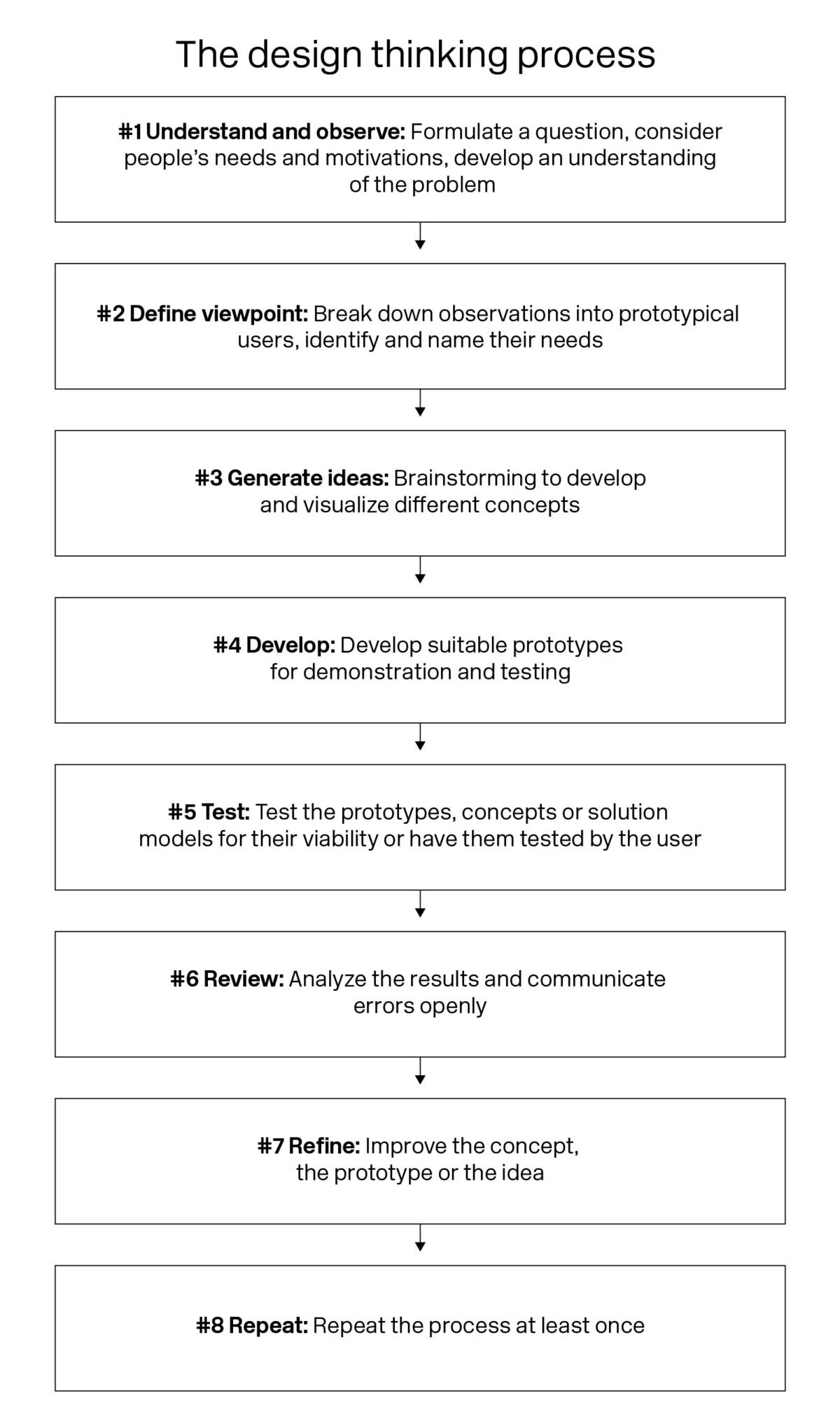Design thinking: Merely a buzzword these days, or still an innovative creative approach?
In part 1 of our three-part series on design thinking, we invite you to take stock: How is design thinking doing? Is it still THE innovative approach to brainstorming or has it already had its day?

On its way into the mainstream has design thinking lost its meaning?
Design thinking has been an established approach in product development for years and has become an integral part of innovation and development processes. Countless books and articles online describe the approach and its application in various contexts from different perspectives. As a result, the concept has become more and more popular as it was adapted by a wide range of industries and sectors and applied to their questions and needs.
Large corporations benefit from the practice of design thinking in particular – and actually they do so mostly while not consistently executing the approach as intended by the inventor. This is because, in corporations especially, even the product developers hardly ever come into contact with the final users of the products or services they create. The user-centric approach and the absolute necessity to see things from the user’s perspective during the design thinking process help to gain valuable insights into the UX from the user’s perspective.
In addition to the “traditional” application of design thinking in product development, the approach is increasingly finding acceptance in other company divisions. The reasons for this are, first and foremost, the challenges that digitalization poses to companies and the pressure to innovate that this brings.
Design thinking incorporates different perspectives and offers a flexible framework to arrive at innovative, customer-centric solutions. As a creative method, design thinking can, for example, ensure that content marketing is seen as a holistic collaboration project between various company divisions and is practiced as an interdepartmental discipline.
But this is where the danger of a widespread misconception also lurks: design thinking is often only used nowadays as a label to describe any form of interdepartmental collaboration and an observation of the market from the customer’s perspective.
This raises the questions:
- Does this even achieve the actual intention of the approach?
- Has the approach become a method and have its contents long been the reality, or does it still harbor innovative potential?
- What else can design thinking offer?
Let’s first take a look back …
Where does design thinking come from?
The approach originates from computer science. The developers and inventors Terry Winograd, Larry Leifer and David Kelley founded the innovation consultancy firm IDEO in Palo Alto, California, in 1991 to commercially market design thinking. In 1992, the Design Thinking Research Symposia (DTRS) series, which is still successful today, was launched.
Hasso Plattner, co-founder of SAP, is a major supporter of the development and dissemination of the method. Thanks to him, design thinking has been a subject of study at Stanford University since 2005, and it has been taught at the Hasso Plattner Institute in Potsdam since 2007.
Tim Brown, the current president and CEO of IDEO, defines design thinking as follows:
“Design thinking is a people-centric approach to innovation that uses the tools of a designer to integrate people’s needs, the possibilities offered by technology and the requirements for business success.”
Back to basics: What basic assumptions is design thinking based on?
As the name suggests, design thinking is about design. But this does not mean the product design per se. Since the term originates from the USA, “design” in this context is understood more as a comprehensive problem-solving and product development process.
The approach is based on a central basic assumption: all areas of life can be designed, in other words actively shaped. Concepts and products are only meaningful and valuable if they are oriented towards real human needs and are able to solve real human problems. Complex questions require a target-oriented creative process to arrive at a suitable solution.
Another assumption is that problems can generally be better solved if people from a vast array of disciplines, fields and hierarchical levels come together in an environment that fosters creativity and, in an atmosphere characterized by an open error management culture, let their innovative strengths have free rein under certain conditions. In this way, a wide range of perspectives and experiences flow into solutions. This raises the probability of finding new, innovative approaches.
The design thinking process as an iterative model
The model of the design thinking process consists of, depending on the definition and the specific field of application, more or less firmly defined phases:

Unrealistic and unattainable targets are sometimes deliberately set as motivation to achieve maximum creativity. The approach includes divergent and convergent elements and uses different, variably interchangeable methods within the individual steps.
For the approach to work and be able to produce convincing solutions, three basic principles are of equal importance: team, space and process. In other words, the pure application of the process will not lead to good results .…
- if the team composition is not suitable for the concept development,
- the space suppresses the creative generation of ideas, or
- the mindset of those involved is not open enough for the practice of design thinking.
The actual process is therefore only one component of the overall design thinking approach.
The process of design thinking is iterative, in other words it must be repeated in loops as often as possible, before the start and also during the course of a project. Ideas and solutions thus become more and more concrete in constant connection with and feedback from the customer perspective.
However, several days should always be allowed for one process cycle. The process is not linear; one or more steps backwards or a complete restart are possible at any time. Finding ideas and solutions with design thinking is a lengthy process for everyone involved. Not every company wants to allow itself this time.
Misunderstandings and misinterpretations of design thinking
A classic misinterpretation of the approach, but one that is very often found in well-meaning guides to applying design thinking in the professional and interpersonal field, is the overemphasis on empathy. Design thinking involves more than “just” empathizing with your customers or your counterpart and being able to show understanding for them.
Such an understanding falls far short of the mark and does not do justice to …
- the complexity of the approach,
- the purpose of design thinking,
- the goals of design thinking and
- the scope of its consequences for the culture of a company.
“We have integrated design thinking into our processes to better understand our customers” is therefore an implausible claim.
No one who has ever experienced and helped shape a design thinking process is a proven design thinking expert. This is mainly because the process is extremely flexible and variable in many of its phases with regard to method selection. Each product, each question and each objective can demand and justify different methods of finding solutions.
To get an initial introduction to the approach, to become familiar with different methods and to be able to apply these profitably in different situations of a design thinking process requires a lot of time and practical experience. It is not for nothing that there are entire training programs and courses of study specializing in design thinking.
You don’t practice design thinking on the fly at weekly meetings or in workshops. The process takes at least several days, if not months, as it must be carried out in parallel with projects. It is also worth not thinking of design thinking in isolation, or misinterpreting it as a method.
Rather, it is an integrative approach that can have a much greater impact in combination with other agile methods. These include:
- Lean startup
- Scrum
- Kanban
Opening yourself up to design thinking requires a lasting change and shift in existing internal processes.
Outlook: Design thinking in the product development process
Are you toying with the idea of integrating design thinking into your product development process? Then first ask yourself the question: What exactly does my company need design thinking for in our environment with our challenges? If you can give a concrete answer to this question, you will know which parameters to fine-tune in order to integrate the approach in a meaningful way.
In part 2 of our series, learn about the potential harbored by design thinking for product development and sales and what is needed to implement the approach in a meaningful way. Part 3 will use specific examples to demonstrate the impact it has on a company when design thinking is integrated into the corporate culture as a creative process.
All three parts of the trilogy on the topic of “Design Thinking” plus four different use cases and numerous additional information and insights can be downloaded here as one compact e-book free of charge.






